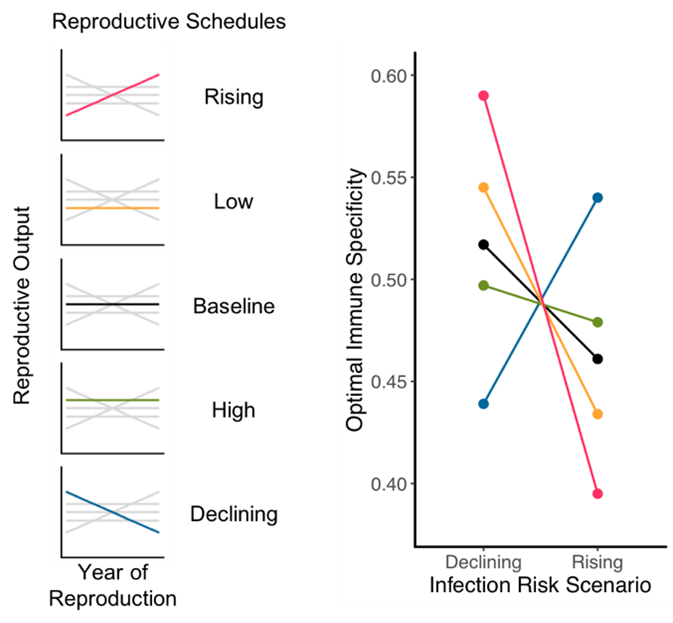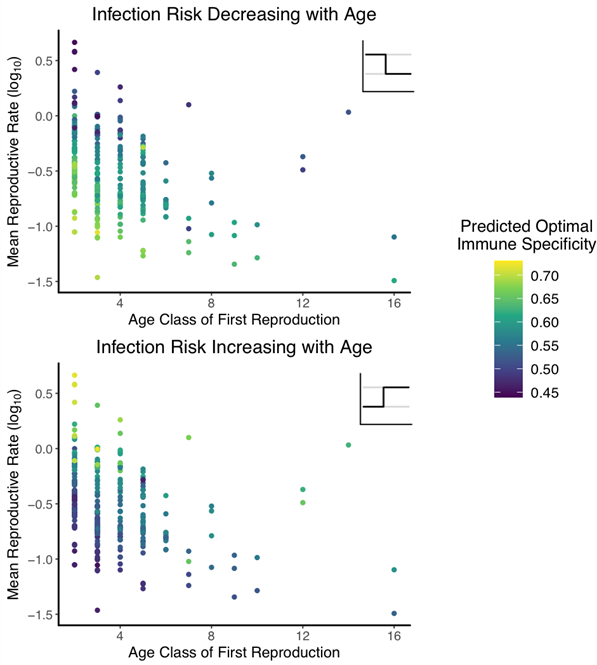New bioRxiv preprint from Alec Downie et al. using COMADRE!
by Chelsea C. Thomas on Apr 8, 2021The following is a post from Alec Downie.
Immune defense is a vital part of an organism’s strategy for maximizing fitness. The immune system protects against the ever-present mortality threats posed by parasites, but deploying these defenses requires resources that may be used for growth or reproduction, and excessive immune responses can be dangerous to the host. Accordingly, optimal immune strategy depends on the particular risks an organism faces from infection, disease-induced mortality, and immunopathology. Much theoretical and empirical research has been devoted to the relationship between life history and immune strategy. One understudied aspect of this question is what happens when infection risks vary with age, a well-documented phenomenon in many animal species. And, correspondingly, researchers have rarely considered how nuances of demography shape an organism’s optimal immune strategy under such epidemiological scenarios. We explored the influence of within-lifespan variation in infection risk and demography via a model of the specificity/sensitivity trade-off of immune defense.
We started with a simple approach looking at how optimal immune specificity (the specificity maximizing population growth rate) varied under five different schematic reproductive schedules with different magnitudes and distributions of reproductive output. More specific, less sensitive immune strategies produce less immunopathology but also more often fail to identify parasites, while less specific, more sensitive strategies do the opposite. Accordingly, past research has shown that organisms should have a more sensitive strategy if parasite threats are greater, while more specific strategies are more successful if parasite threats are lower or immunopathology threats are greater. In our analysis, when infection risk is constant throughout life, then the optimal immune specificity is the same for all five of our reproductive schedules. However, when infection risk declines at reproductive maturity, we find that schedule does shape optimal immune specificity, with earlier-skewed and higher reproductive output associating with less specific (and therefore more sensitive) optimal strategies. But when infection risk rises at reproductive maturity, this relationship flips, so that earlier and higher reproductive output associate with more specific strategies. These results indicate that the relationship between reproductive demography and optimal immune strategy is dependent on the epidemiological context.

We next wanted to expand beyond arbitrarily-defined reproductive schedules to a more complete understanding of the relationship between life history and immune strategy. We were particularly interested in describing the relationships between specific life history traits and optimal immune specificity. This requires a broad variety of demographic patterns. We thus turned to the COMADRE database of animal matrix population models to provide us with life histories documented from wild populations. We extracted life histories for 298 animal populations representing 129 chordate species. For each matrix we adapted the survival curve to allow us to explore the fitness effects of a range of immune strategies under different epidemiological scenarios. We then combined the adapted survival curves with the original fertility schedules from the relevant population matrix, such that we were studying life histories that approximated those of natural populations. By using the COMADRE database as the basis for our life histories, we could explore a realistic demographic trait space and capture the interlocking effects from various aspects of life history on immune defense.
For each of these approximated life histories we identified the immune specificity maximizing fitness, giving us predictions in each epidemiological scenario for 298 matrices. We then analyzed the relationship between predicted optimal immune strategy and three specific life history traits: age at first reproduction, mean reproductive rate, and reproductive life expectancy. We found that each of these traits is associated with optimal immune specificity, but the strength and direction of the association depends on whether infection risk rises or falls at reproductive maturity and the magnitude of that change. And the direction of the association in a given context differs for different traits. When infection risk declines at reproductive maturity, age at first reproduction and mean reproductive rate both negatively associate with immune specificity, while reproductive life expectancy has a positive association. But when infection risk rises at reproductive maturity, the sign of each of these relationships flips. And each life history-immune specificity relationship is stronger when infection risk changes more at reproductive maturity.

Our results highlight how the confluence of life history and epidemiology shapes optimal immune strategy. Consistent relationships between given life history traits and immune specificity may not exist, but rather reflect the parasite risks an organism faces and their dynamics with age. By working with matrices from the COMADRE database, we are also able to highlight the importance of demographic nuance in understanding immune defenses. For example, while both a longer reproductive life expectancy and a later age at first reproduction are considered part of a slower life history, they actually display opposite associations with immune specificity in our model. And although we focused our analysis on animal life histories, we believe that the insights for the interplay between immune specificity, life history, and epidemiology could apply more broadly to include other taxa, like plants and prokaryotes. Ultimately organisms must weight their overall immune strategy based on the different risks they face, the duration of those risks, and the differing costs to fitness from mortality in different life stages.
Optimal immune specificity at the intersection of host life history and parasite epidemiology
A. E. Downie, A. Mayer, C. J. E. Metcalf, A. L. Graham
https://www.biorxiv.org/content/10.1101/2021.03.11.434955v1


